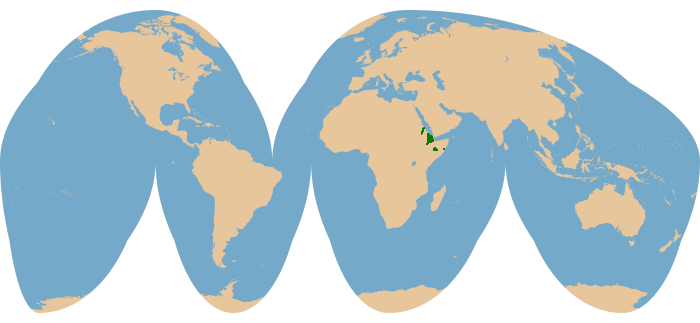Kingdom: |
Animalia Chordata Mammalia Artiodactyla Ruminantia Bovidae Antilopinae Antilopini Nanger |
Common name:
Scientific name:
Other names: |
Soemmerring's gazelle
Nanger soemmerringii
Aoul, Gazelle de Soemmerring, Sömmerring-gazelle |
Physical Characteristics
- Head and body length:
125-150 cm
- Shoulder height: 81-90 cm
- Tail length: 18-23 cm
- Adult weight: 28.5-38.6 kg
- Shoulder height: 81-90 cm
A large, heavyset gazelle; males are larger than females and have particularly robust necks. The general body color is pale yellowish-brown and the undersides are strikingly white; the two colors meet in a sharp horizontal line across the flanks. A large white rump patch extends above the base of the tail and protrudes forward on each hip in a characteristic point. The tail itself is white with a black tuft of hair at the tip. The face is strikingly marked with bold stripes. The centre of the face, from the horns to the muzzle, is deep reddish-black, bordered by striking white stripes. Another black stripe on each side of the face runs from the horns, through the eye, to the muzzle. The chin and upper throat are white. Both sexes have distinctive question-mark-shaped horns with tips that curve inwards. Horns of males are heavy and deflect backwards from the forehead; the basal two thirds are heavily ringed with 14-22 annulations. Typical horn length for males is 38-48 cm, but exceptional specimens may exceed 58 cm. Horns of females are much thinner and less laterally curved, and are typically shorter (exceptionally they may exceed 40 cm).
- Similar species
- Grant's gazelle (Nanger granti) also lives in East Africa, but has a more southerly range. Both species lack a dark flank strip (seen in most small gazelles), but can be easily differentiated by horn shape and the high contrast of the facial markings in Soemmerring's gazelle.
Reproduction and Development
- Gestation period: 6.5-7 months.
- Litter size: One.
- Weaning: Around 6 months.
- Sexual maturity: Females at 18-21 months.
- Life span: Up to 15.5 years.
- Litter size: One.
In the wild, Soemmerring's gazelles breed year round; calves have been recorded in every month in Ethiopia, although they were observed in lower numbers between October and December. Infants weigh 3.5-4.5 kg at birth, and typically lie cached in dense vegetation for the first month.
Ecology and Behavior
- Family group: Females typically live in small herds of 3-5 individuals. In open habitats herds tend to be larger: 5-20 individuals are common, but they may number 50-150 or even 250 individuals. Mature males tend to be solitary, associating with females when they enter their territories. Young males may form small bachelor groups.
- Diet: Primarily grasses and herbs.
- Main Predators: Cheetah, African wild dog, lion, hyena. Young are susceptible to predation by smaller carnivores, including caracal, serval, jackals, birds of prey, and pythons.
- Diet: Primarily grasses and herbs.
Habitat and Distribution

Conservation Status
- IUCN Red List:
Vulnerable (2016).
- CITES Listing: Not listed (2017).
- Threats: Illegal hunting and habitat degradation, particularly overgrazing by livestock.
- CITES Listing: Not listed (2017).
The total population is estimated to be 6,000-7,500 individuals, and continues to show declines across the species' mainland range. Approximately half of the world population - estimated at 3,000-4,000 animals - inhabits Dahlak Kebir Island (Eritrea), where the species was likely introduced historically.






